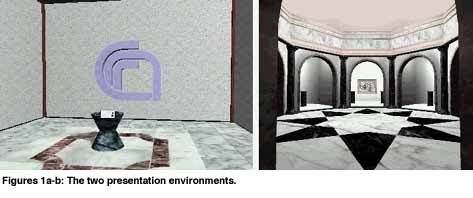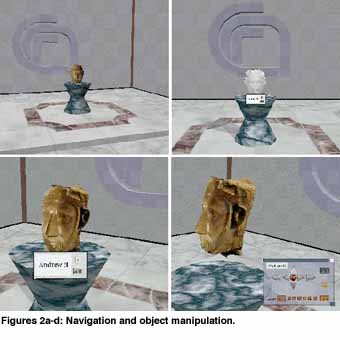Virtual Galleries for Browsing Cultural Collections
by Roberto Scopigno
A methodology for the visual presentation in web environments of three-dimensional works of art, resulting from a standard SQL query to distributed archives is proposed by scientists at IEI-CNR. Remote visualization of dynamic result sets on the Internet is performed using a standard and low cost HW/SW architecture. Moreover, the user is provided with an innovative visual metaphor for the analysis and investigation of the objects presented and the prototype has been designed to offer capabilities which go beyond visualization (eg manipulation).
Our contribution to the Aquarelle project is the design of a 3D data presentation component. The goal is therefore not to build the virtual representation of an existing museum, but to enable the presentation of a hypothetical museum which presents a dynamic set of 3D artistic artifacts. Given the architectural characteristics of Aquarelle, the 3D data presentation component should fulfill the following constraints:
- the presentation environment has to be dynamically configurable, to provide room for a dynamic and variable number of objects (ie the result of a user query to the distributed archives)
- low performance workstations are the target remote clients (preferably personal computers with low cost 3D graphics cards)
- graphics standards have to be used, both to represent 3D data and to visualize or navigate 3D spaces:
- all the data are transmitted on the Internet, and thus data size has to be as low as possible.
To fulfill these requirements, we designed the 3D data presentation component by adopting the de facto standard VRML 2.0 data specification language, and using public domain VRML plug-ins for HTML browsers. The 3D objects to be shown (result of a query) are immersed at run time in a presentation environment which follows the metaphor of a virtual museum hall. Users may navigate the museum area and discover/manipulate the 3D items presented. We want to maintain a clear logical separation between the objects to be shown (known only at run time) and the presentation space, ie the virtual museum architecture.
To improve usability, navigation in 3D space is driven by the standard navigation GUI of the VRML plug-in. The application-dependent part of the GUI (whose main purpose is to drive the manipulation of objects) is included in the 3D scene as a special purpose object, following the metaphor of a flying legend.
In the framework of the Aquarelle User Client architecture, 3D data visualization is performed by the two following sub-components:
- 3DSceneBuilder: given the 3D objects which are the result of a query to the Aquarelle system, the 3DScene Builder builds a virtual scene on the fly which embeds the 3D objects in the presentation environment
- 3DBrowser: it visualizes 3D data and supports interactive navigation in the Virtual Museum. Specific interactions with 3D objects can be supported by developing scripts (using the VRML 2.0 scripting language) and including them directly in the presentation environment.
The 3DSceneBuilder is the original component of our proposal and performs on-line scene composition and keen management of complex data. It is imple-mented as a CGI-bin, and it is replicated on the archives which store 3D data.
A logical and physical separation is maintained between the objects' geometry and the presentation environment. The presentation environment specifies the design of the virtual space in which the 3D objects are immersed. It also contains the specification of available user-objects' interactions and of the behaviour of the elements in the virtual museum. Different presentation styles could be supported by the design of different 3DSceneBuilder modules. We have designed two different Virtual Museum presentation environments, shown in Figure 1: a simple squared hall, with a single pedestal, and a more aesthetically pleasing and modular environment. The latter can be assembled starting from instances of two modular components, an octagonal hall and a corridor, to allow the presentation of a number of objects unknown a priori.


Virtual navigation control is in charge of the standard browser interface. Other non standard interactive actions were implemented through VRML scripts. The two metaphors we used in the design of the GUI of the system are those of the pedestal and the legend: each object is placed on top of a pedestal and a legend is created for each pair object/pedestal (Figure 2). The legend is implemented as a complex 3D widget. In non-active state, the legend stays in front of the object's pedestal and shows only the (short) name of the associated object. Users may activate the legend by clicking on it. Activation corresponds to a change in appearance and a change of location (the legend now flies in the 3D space, following the user's line of sight, in order to be always visible during the navigation in the presentation space). It also shows other buttons which allow the user to: select the level of detail used in rendering the 3D objects; select the rendering quality (eg map color textures or not); manipulate the object; activate a link to an HTML page with information on the represented object.
A prototype of the current implementation has been released (http://miles.cnuce.cnr.it/cg/aquarelle/info.html).
Please contact:
Roberto Scopigno - IEI-CNR
Tel: +39 50 593304
E-mail: r.scopigno@cnuce.cnr.it
